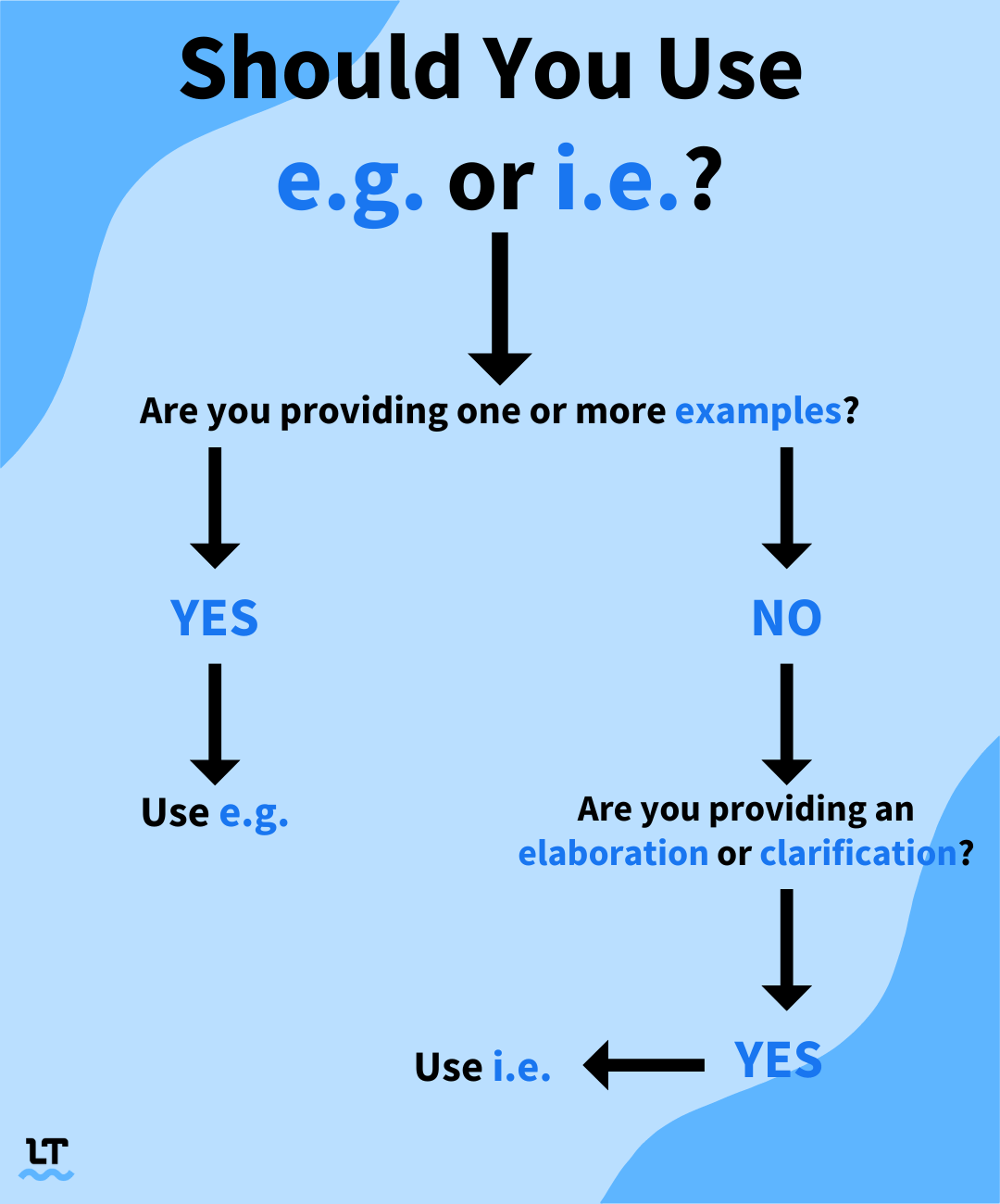
You’ve probably come across the abbreviations “i.e.” and “e.g.”, but do you know what they stand for? We’ll go over what “i.e.” and “e.g.” mean and how to use them in a sentence.

E.g. and i.e. are both abbreviations for Latin expressions. E.g. stands for “exempli gratia,” which translates to “for the sake of the example.” I.e. stands for “Id est,” which translates to “that is.” E.g. is used to give examples, whereas i.e. is used for elaboration.
E.g. and i.e. are two abbreviations that are commonly used in written English. They can be extremely useful while writing, as they help keep your text clear and concise.
However, e.g. and i.e. can’t be used interchangeably. Below, we’ll go over what e.g. and i.e. stand for and show you how to use them in your writing correctly.
E.g. is an abbreviation for the Latin expression “exempli gratia,” which translates to “for the sake of the example.” As you may have guessed, e.g. is used to introduce examples.
We read several books by Dan Brown (e.g., “Angels & Demons”, “The Da Vinci Code”, and “Inferno”).
Popular to contrary belief, e.g. does not stand for example given. However, example given can still be used as a mnemonic device to help you remember that e.g. precedes examples.
Remember, e.g. is one of many alternatives you can use in place of for example.
It’s important to use proper punctuation when using e.g. in a sentence to avoid confusing your audience.
E.g. can be found within a sentence with or without parentheses.
We’re going to take the campers on several activities (e.g., kayaking, swimming, and rock climbing).
My physical trainer taught me many exercises, e.g., deadlifts, squats, and lunges.
E.g. should always contain a period before and after the “g,” and a comma after it. This holds true whether you’re using them within parentheses or not.
There’s so much I have to bake (e.g., cake, cookies, and cupcakes).
There’s so much I have to bake, e.g., cake, cookies, and cupcakes.
When not using e.g. within parentheses, it’s common to find a comma before it in addition to the one after. However, this varies depending on which style guide you’re following.
I.e. is also an abbreviation for a Latin expression: “id est,” which translates to “that is.”
I find comfort in unusual things (i.e., cleaning the entire house).
I.e. is used to elaborate or clarify the previous statement. It does not introduce examples. Although i.e. does not stand for “in essence,” you can use that as a mnemonic device.
I.e. follows the same punctuation rules as e.g.
So, you can find it being used within a sentence with or without parentheses.
He always remembers the small details (i.e., I prefer butter to cream cheese on my bagels).
He always remembers the small details, i.e., I prefer butter to cream cheese on my bagels.
I.e. must always have a period before and after the “e,” along with a comma after the period, regardless of whether you’re using it in parentheses or not.
I learned about love languages (i.e., mine being physical touch and words of affirmation).
I learned about love languages, i.e., mine being physical touch and words of affirmation).
When not being used within parentheses, i.e. is also commonly found with a comma preceding it.
Zack is passionate about conservation efforts, i.e., planting trees, recycling, picking up trash, and cleaning up beaches.
Keep in mind that both i.e. and e.g. are always lowercase and do not need to be italicized.

I.e. and e.g. are incredibly useful while writing.
Use the mnemonic device “example given” to remind you that e.g. is what precedes a brief list of examples. “In essence” can help you remember that “i.e.” is what precedes an elaboration or clarification.
If you want to make sure you’re using correct punctuation while using these abbreviations, use LanguageTool as your writing assistant. Not only will this advanced spelling and grammar checker correct punctuation errors, but it can also easily provide synonyms or rephrased sentences. Plus, it supports over thirty languages and is free to try!
Share on Social Media
Gina holds a Bachelor of Arts in English. With a passion for creating art with words, she spends her free time reading and writing. And no, we didn’t force her to say that. You can find her strolling the shorelines with her loyal canine companion, Mango, or (painfully) cheering on her favorite team, the Miami Dolphins.
Go well beyond grammar and spell checking. Impress with clear, precise, and stylistically flawless writing instead.
We’ve made a mistake, forgotten about an important detail, or haven’t managed to get the point across? Let’s help each other to perfect our writing.

Table of contents * Good morning in English * Is it goodmorning or good morning? * Other ways to say good morning Good morning in English Good morning is an English expression used when greeting someone first thing in the morning. It’s light and casual but appropriate to use in virtually all

We’ll teach you what the phrase “pros and cons” means, how to use it, and why writing one of these lists can help you when faced with a difficult decision. Plus, we’ll also provide a list of synonyms to expand your vocabulary.

Whether you’re writing a story and want to perfect the characters within it or simply wish to expand your vocabulary, this blog post helps with both as it explores the meanings of “protagonist” and “antagonist” and provides examples of each.